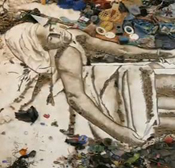Wasteland Documentary States Protagonist Desire
I recently watched the Oscar-nominated documentary “Wasteland” (available on Netflix). I was thrilled to discover an excellent example of a storytelling principle that I shared during my keynote speech at the DV Expo a few weeks ago.
I call this storytelling device the “Protagonist’s Statement of Desire”, and it’s a great way of focusing your viewer on the film’s narrative arc. After my talk, one of the filmmakers came to the podium to share her excitement about learning this new storytelling technique and how she would use it in her film.
But before I continue this tutorial, let me first make two quick announcements. First, I’m happy to say that my Inner Circle is full. If you’re interested in the next 6-month Inner Circle program, I’ll be offering it again in mid-January, 2012.
Second, I’m now making my online courses available as m4v files, which means you can download them to your iPhone or mobile device. As busy as we all are, this is a great way to improve your understanding of documentary structure and style while you drive, bike or work out.
For a limited time, you can get ALL of my critically acclaimed home study courses for the price of ONE. Go to:
https://newdocediting.com/products/
Now back to “Wasteland”, a documentary that won Best Audience Award at the 2010 Sundance Film Festival.
Filmed over three years, “Wasteland” follows protagonist Vik Muniz, a world-famous artist, who returns to his native Brazil to create art from the world’s largest garbage dump.
In order to set up this quest, directors Joao Jardim and Karen Harley employ Muniz’s voiceover to reveal his object of desire.
Early in the film, just after the inciting incident, Muniz says, “What I really want to do is to be able to change the lives of a group of people with the same materials that they use everyday. And not just any material. The idea that I have for my next series is to work with garbage.”
Note the phrase “really want to do” in the first sentence. The Protagonist’s Statement of Desire usually contains a word like “want”, “intend”, or “goal”.
Eliciting such a statement of intent during your interviews gives you a powerful tool for focusing your viewer on the quest.
If you can’t get your protagonist to articulate what they are wanting, try getting that succinct line from another character, someone who can state what the protagonist is after.
If you’ve already shot your interviews, consider scheduling a pick up interview (audio only) and then just use the voiceover.
If all else fails, your film’s narration can deliver the Protagonist’s Statement of Desire, whether it’s spoken narration or text on screen exposition.
Stating explicitly what your protagonist wants in Act One orients the audience to your film’s narrative backbone.
I hope you’ve found this storytelling principle useful. Let me know if you have an example of a Protagonist’s Statement of Desire to share from your own film, or from a documentary you’ve recently seen.
If you’ve found this strategy helpful, you’ll find dozens more documentary storytelling strategies in my online home study seminars. Again, for a limited time, you can get all my seminars for the price of one at:
